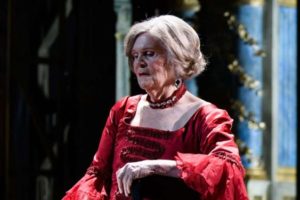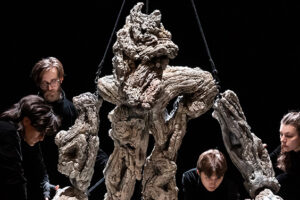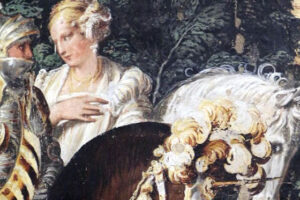

This is the end of the “Figaro Unbound” project here which included a long list of special museum events, film screenings, lectures, theater performances and modern adaptations of Beaumarchais’ works. Its centerpiece is the first performance of the operatic “Figaro Trilogy”: John Corigliano’s Ghosts of Versailles followed by Rossini’s Il Barbiere di Siviglia, culminating fittingly, with six performances of Mozart’s great classic at the Music Center downtown.
Some operas are nearly performance-proof. You can see a student production of La Bohème and still get a serious case of sniffles in the last act despite meager production values and fledgling performers. Mozart’s Nozze is also commonly programmed for students because of the opportunities it affords a large cast of varying proficiency. But when you have rare talent in every sphere working in conjuction you realize what it takes to breathe the ultimate life into a masterpiece and show its humanity.
This is a revival of Ian Judge’s splendid production that he staged for LA Opera in 2004 under then Music Director Kent Nagano. Happily, a glittering new quartet of soloists afford equal pleasure to the eye and ear.
The attractive and ingenious sets of Tim Goodchild, evocatively shaded and lit by Mark Doubleday, provide boldly colored, human-sized, rooms for the action in the Count’s villa. The emerald study of Act III and a last act garden of Italian cypress are possibly the best representations I’ve seen to disguise the machinations of Beaumarchais’ characters. Indeed in the garden a large moon hangs over the villa in the distance and when Figaro sang,”All is ready… the night is dark” the light of a hundred diamond stars threw the action in the foreground into dim silhouette.
Deirdre Clancy’s stylish costumes place the action more or less in the 1950’s. The simplicity of Susanna’s muted lavender maid’s outfit nicely contrasted with Marcelllina’s brazen couture. Figaro sported the standard vest combo, but at least he got trousers instead of breeches. The Count and Countess both superbly attired for their station in bold, deep, colors.

Lucy Schaufer made much of Marcelina’s sassy costumes and certainly isn’t the first in this role to display more character than mezzo. Both Ms. Schaufer and Mr. Brubaker were shorn of their arias in the last act and while I appreciated what it did for the running time, especially when played with one intermission, it denied them their only solo turns.
The Cherubino of Renee Rapier presented a youthful mezzo of real character and excellent comic timing.
The production was anchored by the Figaro of Italian basso Roberto Tagliavini, in his debut with LA Opera, who displayed a plush, rich sound and a crisp rhythmic sense. A deft comedian, he was especially fine in his last act “Aprite in po’ queli occhi,” an aria which normally gives me a case of the fidgets no matter who’s singing. He is tall and lean and displayed himself to excellent advantage while singing with a beautiful attention to dynamics throughout.
Mr. Tagliavini was more than capably partnered by the Susanna of Pretty Yende who made her debut here in 2013 as Micaela in Carmen. Pardon me a moment while I gush, but Ms. Yende is the most graceful and charming woman I have seen on the stage for a very long time. Her self-assured poise and the way she stayed on the balls of her feet routinely throughout kept her character always at the ready. I don’t see this voice getting much larger as she matures, although she has a surprisingly ample and gleaming top. She also has a lovely way of going off the voice momentarily for dramatic emphasis which, although it may be a concession to an instrument that isn’t completely settled, still shows an artist at work. She cast a magic spell over the audience in “Deh vieni, non tardar” and showed an engaging temperament in the miles and miles of Susanna’s recitatives.
Upstairs at Downton we had Ryan McKinny as a Count Almaviva who, after playing Act I like a louche playboy out for a stroll, brought a real imposing menace to his confrontation with the Countess in her bed chamber. He was particularly fine in his Act III showcase with an elegant line and clear articulation in the passagework at the end of the aria which always seems to take so many baritones by surprise. I can’t fail to mention his final,”Contessa perdono” was delivered with such shattering simplicity it could have moved a stone to tears.

Mr. Judge’s production doesn’t futz with the story too much although I take quibbling exception to his giving the Countess and Cherubino a romantic moment at the end of “Voi che sapete.” It gives the lie to her impassioned “non son rea!” later in the scene, though Mozart’s music tells us that she is true. This Mère is not yet coupable.
Otherwise it’s a staging of unusual clarity that builds dramatically in all the ways that it should but rarely does, most especially in the comings and going of the last act which are dexterously handled. Its also exhibits real humor, not just pratfalls and shtick. It was a pleasure sitting among an audience who didn’t think it sacrilege to laugh during Mozart.
James Conlon kept the waves of Mozart’s orchestral ocean rolling and ebbing with a very sure hand. He likes his string tone warm in the modern manner and managed the horn section with calculated discretion. Extraordinarily alert to the needs of his soloists, he was always adept at keeping stage and pit in close accord.
Because it’s played with only one intermission the two final acts are joined. Accompanied but a truly spectacular set change from the wedding dance hall to the garden. You also get to luxuriate in the one moment in the score where Mozart goes from a major to minor key with Barbarina’s “L’ho perduta” uninterrupted. I should also mention the glorious paso doble choreography at the wedding infused with a 1950’s “twist” credited initially to Sergio Trujillo and now to Chad Everett Allen. Brilliant.
There was magic of one kind or another all the way through this performance including the Count’s promised fireworks at the finale.
Photos: Craig T. Mathew / LA Opera
























Comments